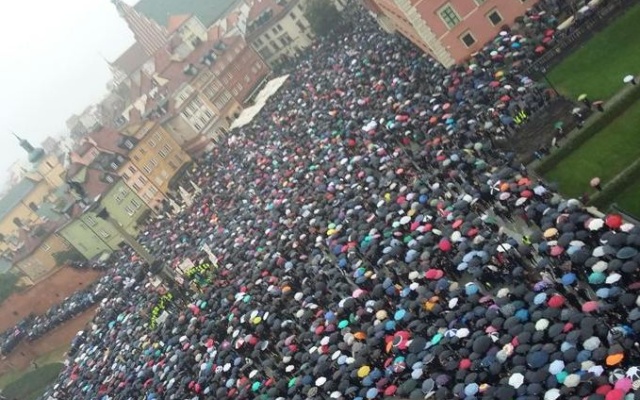The year 2016 may be remembered as the year of the rise of populism. It ought equally to be remembered as the year of the rise of the women’s movement. Poland is the perfect example of a country where both political phenomena coincided, when a new wave of women’s protests broke out against the planned criminalization of abortion in Poland.
Since 1993, the Polish abortion law, one of the strictest in the European Union, has allowed abortion only in cases of incest, rape, genetic fetal abnormalities and when there is a threat to the health or life of the woman. The Polish abortion legislation could be more aptly described as an abortion ban with three exceptions. This is clear from the statistics: between 2002 and 2011 there were altogether 29 abortions when the pregnancy was the result of rape. A threat to a woman’s health and life was the argument for abortion in between 27 to 82 cases per year between 2002 and 2011. Proportionally, genetic fetal abnormality discovered in the course of a prenatal examination has been the most frequent reason for legal abortion, with 82 cases in 2002, rising to 287 in 2007, and 620 in 2011.1 Contraception is not state-refunded and the long queues for gynecologists in the public health care sector make access to contraception on prescription even more difficult. According to the Act of the Professions of Doctor and Dentist, a doctor can refuse medical treatment if it is against his or her conscience and personal beliefs, but must direct the patient to another doctor who can perform the service, as well as record the reasons for refusal in writing. In reality, doctors overstep their rights by, for example, failing to report the state of the fetus or not providing information to the patient about hospitals where legal abortions are performed. Therefore, in respect of women’s reproductive rights, the situation observed in 2016 has developed from bad to even worse.
Polish feminists have fought against Poland’s anti-abortion law since the draconian legislation was introduced in 1993. However, it was in 2016 that the issue gained momentum in the form of massive protests.
After Poland’s 2015 parliamentary elections gave the right-wing Law and Justice Party a parliamentary majority, it was only a matter of time before more restrictions on reproductive rights would be proposed. The government’s decisions to withdraw financial support to NGOs supporting female victims of domestic violence were just the beginning. In early 2016, government leaders, including the Prime Minister, Beata Szydło, signaled their support for a total ban on abortion, while the ultraconservative NGO, Ordo Iuris, started collecting signatures in support of prison sentences for both women and gynecologists, and demanded that the authorities carry out investigations to make sure that apparent miscarriages had not been induced by medical abortifacients.
The actions of Ordo Iuris provoked outrage among women: demonstrations and pickets organized by the newly-formed Gals for Gals, a grassroots organization with a feminist agenda, and a legislative initiative, Save the Women, taken up by a group of social democratic feminists who campaigned to liberalize Poland’s anti-abortion law.
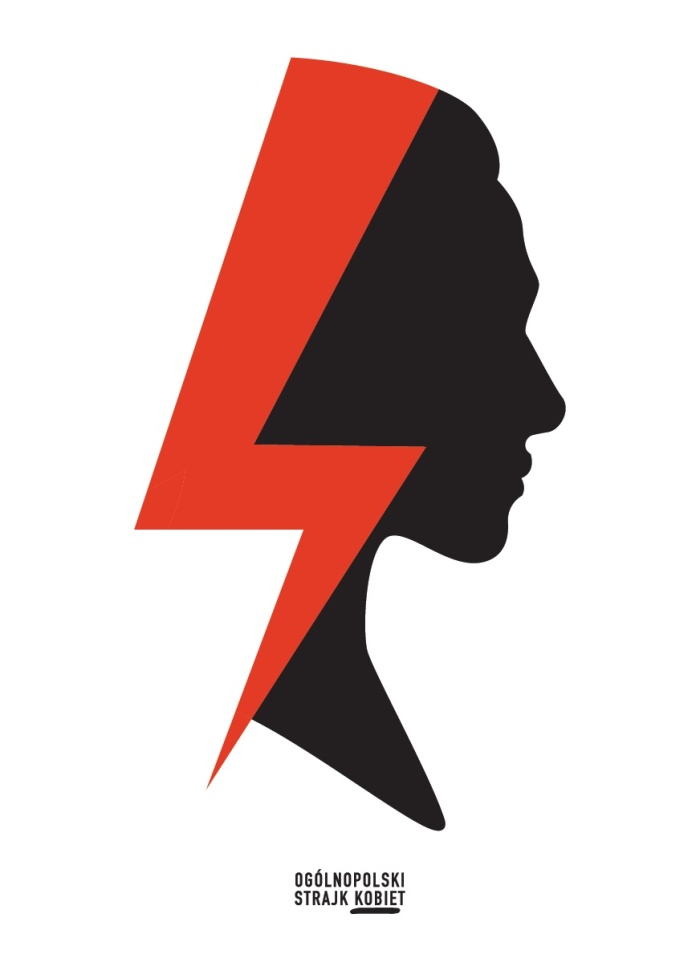
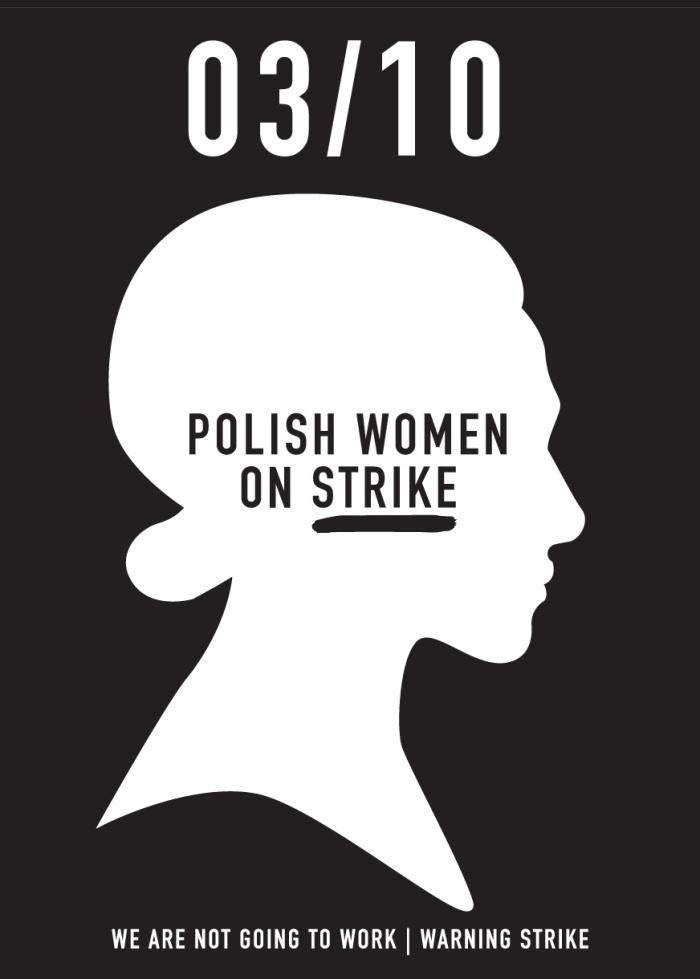
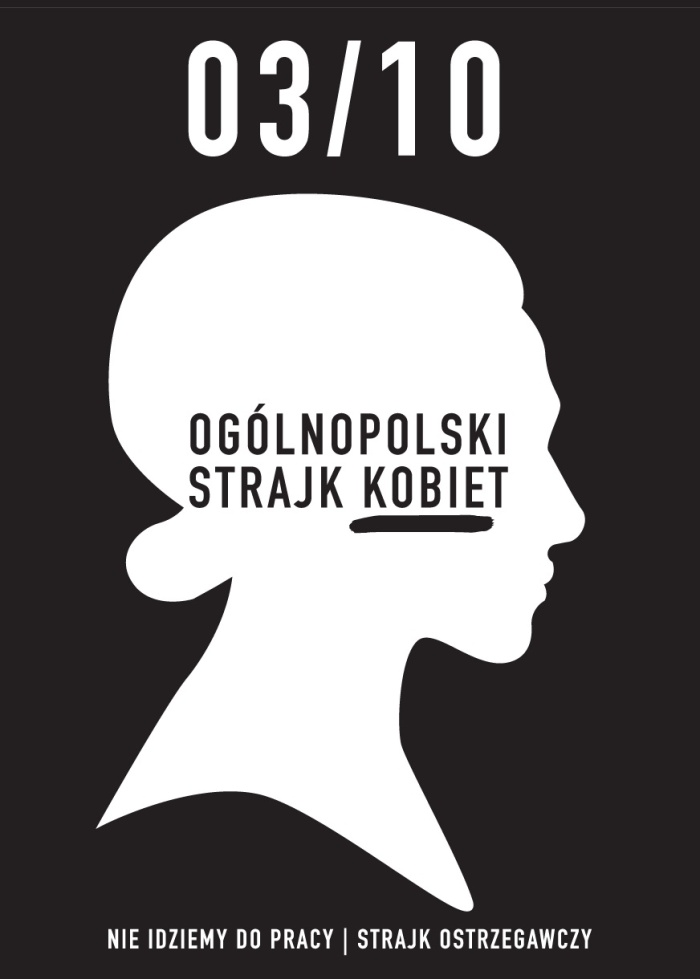
Polish Woman on Strike
Author: Ola Jasionowska
Courtesy of the Artist
Black Monday October 3rd All-Poland Women’s Strike
Ordo Iuris collected over 500,000 signatures in support of its proposal, whereas Save the Women collected 250,000. The Parliament summarily rejected the Save the Women project, continuing instead to discuss the criminalization proposal. Gals for Gals and Save the Women answered with demonstrations, while the left-wing Razem party called on people to dress in black and join pickets and demonstrations and to post photos on social media, using the hashtag #blackprotest [#czarnyprotest]. One of Poland’s most highly regarded actresses called for a nationwide women’s strike, inspired by the 1975 women’s strike in Iceland. The idea was quickly taken up and one of the social media activists announced October 3 as the date for an All-Poland Women’s Strike, dubbed “The Black Protest”. Although the call for action did not initially come from any of the women’s organizations, in the course of the preparations they offered help, time and resources, along with anti-government social movements and opposition political parties. Many local government officials, employers, trade unions, and university faculties expressed their support for the women who wanted to strike.
The Women’s Strike was truly nationwide. Women and girls, together with some supportive men, all dressed in black, organized actions in at least 142 cities and small towns all over the country, involving roughly 150,000 people and actions in at least 142 cities. The scope of the all-Poland mobilization, from the capital to small towns, was an unprecedented political phenomenon. The slogans referred to basic women’s rights, reproductive choice, and women’s dignity, which would be violated by a total ban on abortion. October 3rd was a rainy day, and so most participants stood and walked under umbrellas, which became an unexpected symbol of the protest.
The scale and energy of the protest was a surprise for the ruling party and the Catholic Church; they immediately struck back with explicit misogyny. A Catholic bishop opined that women “are incapable of conceiving as a result of rape”; a populist politician insisted that women should be “controlled” as they were sexually promiscuous, and the minister of foreign affairs called the women completely irresponsible. Nevertheless, three days after the protest, parliament rejected the proposal for a total abortion ban – one of the very few recent defeats for Poland’s ruling party.
The Real Face of Institutionalized Misogyny
The direct impact of the strike was effective – the ruling party dropped its confrontational rhetoric, adopting instead a soft approach. The Prime Minister announced that Polish women who experience a “difficult pregnancy” – a euphemism for cases of incurable illness or fetal deformity discovered during pregnancy – would receive a one-time benefit of some 1,000 euros, effectively a lump sum cash payout for giving birth to a child likely to die soon after birth.2
The soft approach hardened in the following months. The amiable rhetoric of “difficult” pregnancies has faded away, to be replaced by acts of institutionalized misogyny. The government started to question the necessity of the Council of Europe Istanbul Convention on preventing and combating violence against women and domestic violence. At the end of 2016, the Ministry of Health decided to call off the “birth-giving and maternal care standards” that had come about as a result of cooperation between several former Ministries of Health and NGOs in the field of birth quality and the rights of the woman giving birth. The current Minister of Health has formed a new group of experts to formulate “new, better standards,” with the aim of prioritizing the protection and interests of physicians.
Among the invited pundits, one person was a striking choice – Professor Chazan, an obstetrician who in 2014 gained notoriety for deluding his pregnant patient about the state of her severely handicapped fetus in order to avoid performing an abortion. Professor Chazan used as his excuse the “conscience clause” that allows physicians in Poland to refuse abortion if this is against their own views. He violated the legal provision, however, by failing to informing the patient and not providing her with the statutory information about an alternative clinic or contact details for a hospital where she could receive an abortion. The woman gave birth to a child with no brain, who died in painful agony several days later. The “Chazan case” caused a shock and was widely debated in Poland in 2014. Fifty-two percent of Poles thought that doctors should not have the right to refuse certain medical services on the grounds of their own conscience, and 62% were of the opinion that a doctor should not refuse abortion to a woman legally entitled to one. Other issues raised in the public opinion poll give an even better picture of the state of reproductive rights and the effectiveness of the “conscience clause” in Poland: 59% of those interviewed stated that a doctor should not refuse an in vitro procedure to a couple, 55% thought that a gynecologist shouldn’t refuse a prescription for contraception if there were no health contraindications; 73% stated that even in a situation where a doctor was conflicted because of personal beliefs, they shouldn’t refuse to carry out a pre-natal examination or make a referral for one, even if there were a higher risk of a genetic or progressive defect of the fetus.3
Another step the government has taken is to make, yet again, the emergency "morning after" pill available only on prescription. The current Minister of Health has argued that “teenage girls take the pill several times per month,” even though this statement has never been backed up by evidence and could be categorized as “fake news” par excellence. He also declared that he would refuse to provide a prescription for the ‘morning after’ pill to a woman who had been raped.
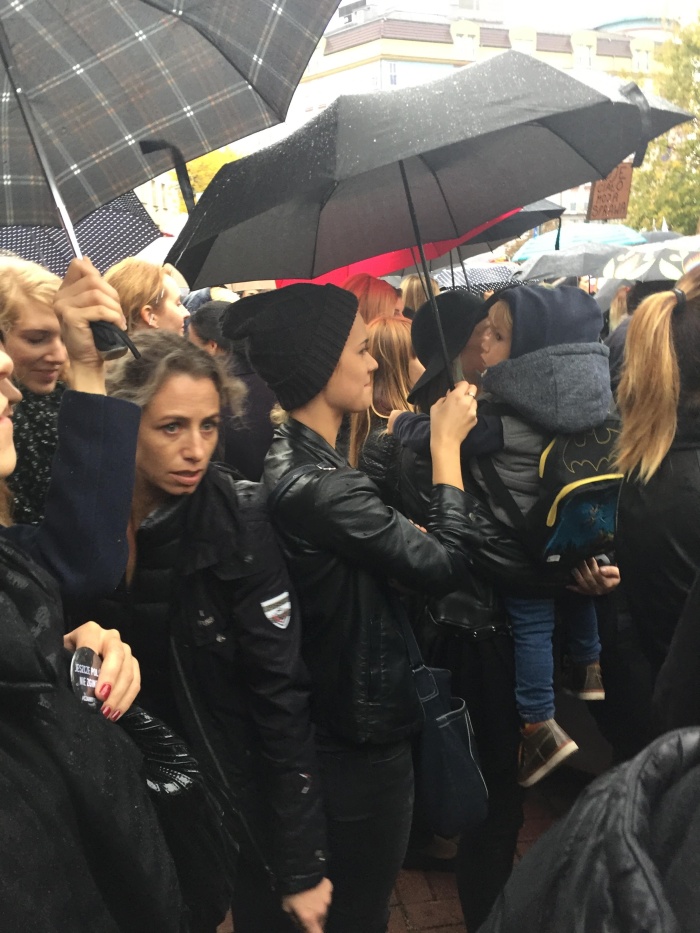
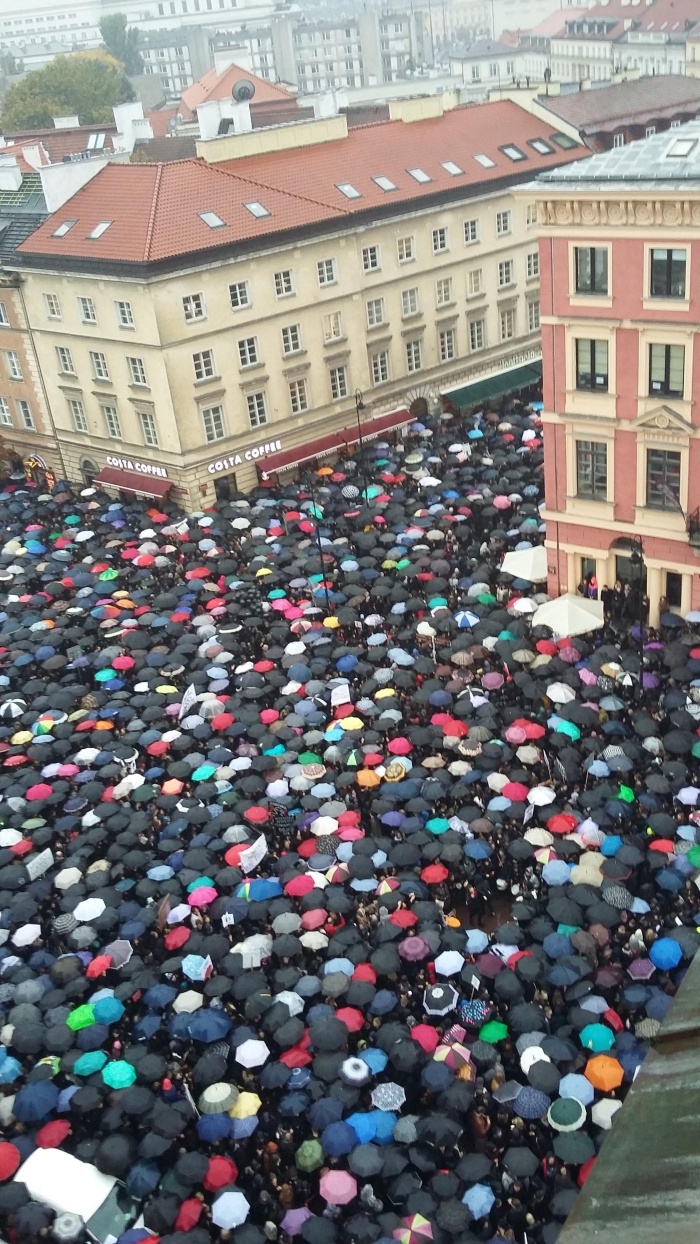
fot. Elżbieta Karolczuk
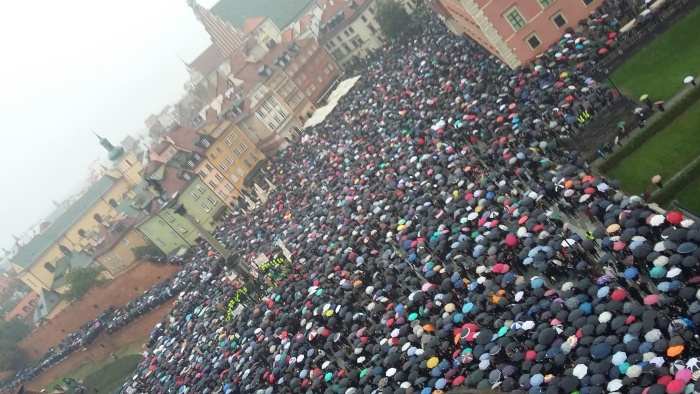
fot. Elżbieta Karolczuk
From an All-Poland to an International Women’s Strike
The All-Poland Women’s Strike and Black Protest continues. In late October 2016 a smaller, second round of strikes was organized, which brought forward an eleven-point agenda, promoting women’s dignity and freedom, opposing sexual aggression, domestic violence, and the militarization of society, and calling for a more women-oriented social policy. The Black Protest inspired at least two celebrities to discuss their own abortions in public, breaking a taboo in public discourse. The Black Protest gained significant public recognition, with 58% of Poles expressing their support. It also gained international recognition, inspiring women in Argentina, Iceland, and South Korea to organize similar protests. Finally, the All-Poland Women’s Strike joined the initiative of the International Women Strike on International Women’s Day.
The government’s political moves to institutionalize misogyny triggered women’s decisions to participate in the International Women Strike. On the 8th of March, demonstrations and pickets, with participants dressed all in black, took place in around 80 cities and towns all over Poland – from numerous marches and events in Warsaw, Krakow, Poznan, and Gdansk, to vibrant and lively demonstrations and pickets in small towns. Just as in October 2016, the slogans and chants referred to freedom of choice, woman’s dignity – opposing violence, and carrying a strong anti-government message.
The Significance of the Black Protest and the All-Poland Women’s Strike
The usual method of assessing the scale of a social protest is to count the actual participants in the events organized. However, the All-Poland Women’s Strike / Black Protest offered other forms of participation. One was to dress in black on the day, a method chosen by those unable to leave their workplace or responsibilities around the house. Another was the use of the hashtag #blackprotest, which enabled many more to take part even though they could not come to the rallies. Since the widespread protests took place all over Poland, the use of social media to show how many people were thinking and acting unanimously was as important as participation in the demonstrations themselves. The Black Protest created a space for action without boundaries. Elżbieta Korolczuk classifies it as a form of connective action that enables emotional engagement, the personalization of a political message, and the use of information technology.4 Some effects were interesting and surprising, as when Occupy Wall St. Facebook page shared a photo of a Black Protest demonstration taken by Anja Rubik, who is Polish and one of the world’s top models; the capitalist beauty and the anti-capitalist rebels joined forces for the cause of reproductive rights.
In the case of the All-Poland Women’s Strike / Black Protest the use of social media and hashtags may be interpreted as an implementation of a feminist inclusive strategy. Ewa Majewska emphasizes that it challenged the traditional relation between the powerful creator and weak, receptive participants.5 The use of social media enabled the participants’ agency in creating their own message, in a non-hierarchical way, from the anonymous to the highly personalized. Polish feminist demonstrations usually offer special seating on buses for parents with children and people with disabilities – for all those who cannot march as fast as the others. To my mind, social media became a virtual bus for those who could not attend in person.
This blurring of time and space that enabled being together created an important dimension for the All-Poland Women’s Strike / Black Protest. It is worth analyzing another blurring – the strike itself. In Poland, strikes are an institutionalized element of collective disputes between workers and employers in the workplace. In formal terms, the All-Poland Women’s Strike was not a strike. And yet it was – as a way of saying, “I disagree, therefore I refuse to work.” The idea of a women’s strike rejects the division into productive and reproductive work. It emphasizes that women still work a double shift and that their reproductive rights are connected both to reproduction and production. Therefore the “refusal to work” gained a deeper meaning. The empowering character of the All-Poland Women Strike / Black Protest was in the takeover of the idea of striking itself and provided an inclusive space for different actions in the cause of reproductive rights.
One of the questions that was frequently asked after 3rd October 2016 was whether the Women’s Strike was against further restrictions or in favor of liberalizing the act of abortion. The popularity of slogans about freedom of choice suggests that women, above all, emphasized that the final decision ought to be up to the woman – even though many probably would not openly support the legalization of abortion in the first trimester. After more than 25 years of one of the strictest abortion laws in Europe, as well as the spread of anti-choice rhetoric and ridiculing of feminist activities, the recognition of abortion as a woman’s right is a difficult challenge for Poland. Nevertheless, it is a goal that can be achieved.
The All-Poland Women’s Strike / Black Protest showed that women are taking back political space and taking back the language. By placing themselves, and their decisions, at the center and declaring that they “will not fold their umbrellas,” they are reclaiming Poland for women.6 The 8th March International Women’s Strike in Poland proved to be a historical milestone by showing that the Black Protest of October 2016 was not an ephemeral, one-time event but a sign of a much more profound discontent shared by thousands of women in Poland.
BIO
Julia Kubisa - sociologist, feminist and collumnist. She works as an assistant profesor at the Institute of Sociology, University of Warsaw. In years 2015-2016 she was a Marie Curie postdoc at the University of Gothenburg, Sweden. She is an author of a book „Bunt białych czepków. Analiza działalności związkowej pielęgniarek i położnych” about the activity and militancy of trade union of nurses and midwives in Poland. For many years she has been fascinated with the phenomenon of gendered division of labour. She studies the gendered character of work and deconstructs assumptions about adequacy and non-adequacy of certain jobs for men and women. In last years she worked in the comparative European projects. Currently she co-writes two books that sum up the findings – on the agency of people who experience poverty, and on the job quality. She cooperates with trade unions. She used to publish in „Przekroj” of Roman Kurkiewicz and she often publishes in Dziennik Opinii/Krytyka Polityczna. She is engaged in feminist movement and she used to be a co-organizer of Manifa – 8th March feminist demonstrations in Warsaw. She was a co-founder of feminist Fundacja MaMa.
[1] Report of the Council of Ministers (2012) on the implementation and the results thereof in 2011 of the Act of 7 January 1993 on Family Planning, Protection of the Human Fetus and Permissible Abortion; Warsaw. p. 51, http://orka.sejm.gov.pl/druki7ka.nsf/0/c170d861fc5d4a3ac1257c680033a257/$file/2067.pdf (accessed 20.04.2017).
[2] Julia Kubisa, ‘Defending Reproductive Rights in Poland,’ Global Dialogue. Volume 7, issue 1, 2017.
[3] Rafał Boguszewski, CBOS 2014 “Klauzula sumienia lekarza i farmaceuty,” CBOS no. 94/2014. Warszawa, http://www.cbos.pl/SPISKOM.POL/2014/K_094_14.PDF (accessed 20/04.2017).
[4] Elżbieta Korolczuk, “Explaining the ‘Black Protests’ in Poland: The Power of Connective Action,” Zoon Politicon Journal (forthcoming, 2017).
[5] Ewa Majewska, „Słaby opór i siła bezsilnych. #CzarnyProtest w Polsce 2016” [Weak Resistance and the Power of the Powerless. #BlackProtest in Poland 2016], Praktyka Teoretyczna, 10 Listopada 2016, (accessed, 20.03.2017: http://www.praktykateoretyczna.pl/tag/czarny-protest/).
[6]Julia Kubisa, “Odzyskajmy Polskę dla kobiet!” [Let’s Reclaim Poland for Women!] Krytyka Polityczna, 10 października 2016 (accessed, 20.03.2017: http://krytykapolityczna.pl/kraj/odzyskajmy-polske-dla-kobiet/2016).



